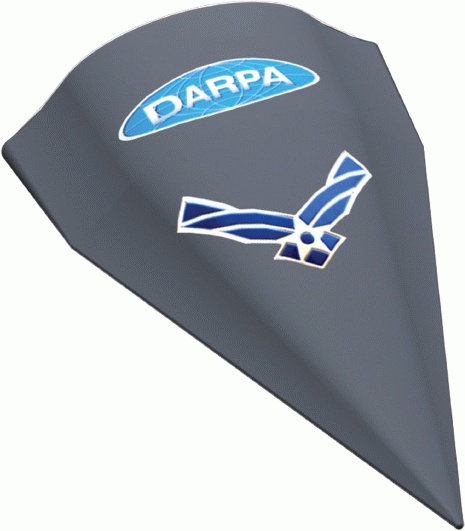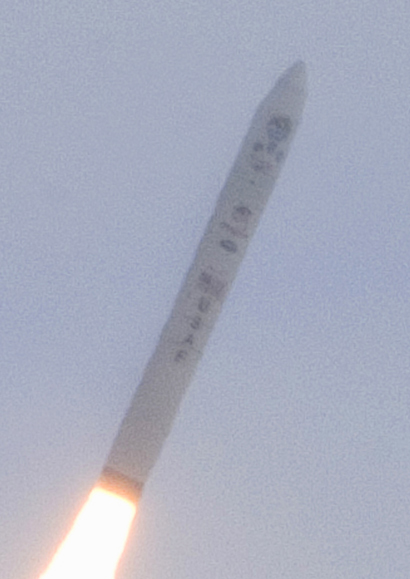Hypersonic Technology Vehicle 2 on:
[Wikipedia]
[Google]
[Amazon]
 Hypersonic Technology Vehicle 2 (HTV-2) is an experimental
Hypersonic Technology Vehicle 2 (HTV-2) is an experimental
 Development of protection structures that are tough and lightweight, development of an aerodynamic shape that has a high lift to drag ratio, development of automatic navigation control systems etc. were some of the initial technical challenges that had been overcome in the final design. The various departments involved in designing the vehicle included aerothermodynamics, materials science, hypersonic navigation, guidance and control systems, endo- and exo-atmospheric flight dynamics, telemetry and range safety analysis. The craft could cover , the distance between London and Sydney, in 49 minutes.
Built by
Development of protection structures that are tough and lightweight, development of an aerodynamic shape that has a high lift to drag ratio, development of automatic navigation control systems etc. were some of the initial technical challenges that had been overcome in the final design. The various departments involved in designing the vehicle included aerothermodynamics, materials science, hypersonic navigation, guidance and control systems, endo- and exo-atmospheric flight dynamics, telemetry and range safety analysis. The craft could cover , the distance between London and Sydney, in 49 minutes.
Built by

 Both flights reached Mach 20 ( high-hypersonic speed) and lost telemetry at 9 minutes of a planned 30-minute mission.
The HTV-2's first flight was launched on 22 April 2010."First Minotaur IV Lite launches from Vandenberg"
Both flights reached Mach 20 ( high-hypersonic speed) and lost telemetry at 9 minutes of a planned 30-minute mission.
The HTV-2's first flight was launched on 22 April 2010."First Minotaur IV Lite launches from Vandenberg"
. U.S. Air Force, 22 April 2010. The HTV-2 glider was to fly across the
"New Minotaur rocket launches on suborbital flight"
spaceflightnow.com, 23 April 2010. In mid-November, DARPA stated that the first test flight ended when the computer autopilot "commanded flight termination" after the vehicle began to roll violently. A second flight was initially scheduled to be launched on August 10, 2011, but bad weather forced a delay. The flight was launched the following day, on 11 August 2011. The unmanned Falcon HTV-2 successfully separated from the booster and entered the mission's glide phase, but again lost contact with control about nine minutes into its planned 30-minute Mach 20 glide flight. Initial reports indicated it purposely impacted the Pacific Ocean along its planned flight path as a safety precaution. The glider's surface reached (the speed and heat caused part of the skin to peel away from the aerostructure) and controlled itself for 3 minutes before crashing.
Darpa Refocuses Hypersonics Research On Tactical Missions
- Aviationweek.com, 8 July 2013
Falcon page on Darpa.mil
"Air Drops Dummy Rocket for Darpa's Falcon"
Aviation Week,
an
* ttp://www.space.com/15388-darpa-hypersonic-glider-demise-explained.html Death of HTV explained{{AFRL spacecraft Hypersonic aircraft DARPA projects DARPA vehicles
 Hypersonic Technology Vehicle 2 (HTV-2) is an experimental
Hypersonic Technology Vehicle 2 (HTV-2) is an experimental hypersonic glide vehicle
Hypersonic glide vehicle (HGV) is a type of warhead for ballistic missile that can maneuver and glide at hypersonic speed. It is used on ballistic missiles to significantly change their trajectories. Conventional ballistic missiles follow a predi ...
developed as part of the DARPA Falcon Project
The DARPA Falcon Project (Force Application and Launch from Continental United States) is a two-part joint project between the Defense Advanced Research Projects Agency (DARPA) and the United States Air Force (USAF) and is part of Prompt Globa ...
designed to fly in the Mach 20 range. It is a test bed for technologies to provide the United States
The United States of America (U.S.A. or USA), commonly known as the United States (U.S. or US) or America, is a country Continental United States, primarily located in North America. It consists of 50 U.S. state, states, a Washington, D.C., ...
with the capability to reach any target in the world within one hour (Prompt Global Strike
Prompt Global Strike (PGS) is a United States military effort to develop a system that can deliver a precision-guided conventional weapon airstrike anywhere in the world within one hour, in a similar manner to a nuclear ICBM. Such a weapon wou ...
) using an unmanned hypersonic bomber aircraft.
Development
The Falcon HTV-1 program, which preceded the Falcon HTV-2 program, was conducted in April, 2010. The mission ended within nine minutes from launch. Both these missions are funded by the US Defense Advanced Research Projects Agency (DARPA
The Defense Advanced Research Projects Agency (DARPA) is a research and development agency of the United States Department of Defense responsible for the development of emerging technologies for use by the military.
Originally known as the A ...
) to help develop hypersonic
In aerodynamics, a hypersonic speed is one that exceeds 5 times the speed of sound, often stated as starting at speeds of Mach 5 and above.
The precise Mach number at which a craft can be said to be flying at hypersonic speed varies, since ind ...
technologies and to demonstrate its effectiveness. Under the original plan, HTV-1 was to feature a hypersonic lift-to-drag ratio
In aerodynamics, the lift-to-drag ratio (or L/D ratio) is the lift generated by an aerodynamic body such as an aerofoil or aircraft, divided by the aerodynamic drag caused by moving through air. It describes the aerodynamic efficiency under gi ...
of 2.5, increasing to 3.5-4 for the HTV-2 and 4-5 for the HTV-3. The actual lift-to-drag ratio of HTV-2 was estimated to be 2.6.
HTV-2 was to lead to the development of an HTV-3X vehicle, known as Blackswift, which would have formed the basis for deployment around 2025 of a reusable Hypersonic Cruise Vehicle, an unmanned aircraft capable of taking off from a conventional runway with a 5,400 kg (12,000 lb) payload to strike targets 16,650 km away in under 2 hours. The HCV would have required a lift-to-drag ratio of 6-7 at Mach 10 and 130,000 ft (40,000m).
Design
 Development of protection structures that are tough and lightweight, development of an aerodynamic shape that has a high lift to drag ratio, development of automatic navigation control systems etc. were some of the initial technical challenges that had been overcome in the final design. The various departments involved in designing the vehicle included aerothermodynamics, materials science, hypersonic navigation, guidance and control systems, endo- and exo-atmospheric flight dynamics, telemetry and range safety analysis. The craft could cover , the distance between London and Sydney, in 49 minutes.
Built by
Development of protection structures that are tough and lightweight, development of an aerodynamic shape that has a high lift to drag ratio, development of automatic navigation control systems etc. were some of the initial technical challenges that had been overcome in the final design. The various departments involved in designing the vehicle included aerothermodynamics, materials science, hypersonic navigation, guidance and control systems, endo- and exo-atmospheric flight dynamics, telemetry and range safety analysis. The craft could cover , the distance between London and Sydney, in 49 minutes.
Built by Lockheed Martin
The Lockheed Martin Corporation is an American aerospace, arms, defense, information security, and technology corporation with worldwide interests. It was formed by the merger of Lockheed Corporation with Martin Marietta in March 1995. It ...
, the HTV-2 is made of carbon composite material; the durability of such material was needed to prevent important internal components from being destroyed because they are a few inches from its surface. The surface temperature of the HTV-2 was expected to reach or more in flight; steel melts at .
Flight testing

 Both flights reached Mach 20 ( high-hypersonic speed) and lost telemetry at 9 minutes of a planned 30-minute mission.
The HTV-2's first flight was launched on 22 April 2010."First Minotaur IV Lite launches from Vandenberg"
Both flights reached Mach 20 ( high-hypersonic speed) and lost telemetry at 9 minutes of a planned 30-minute mission.
The HTV-2's first flight was launched on 22 April 2010."First Minotaur IV Lite launches from Vandenberg". U.S. Air Force, 22 April 2010. The HTV-2 glider was to fly across the
Pacific
The Pacific Ocean is the largest and deepest of Earth's five oceanic divisions. It extends from the Arctic Ocean in the north to the Southern Ocean (or, depending on definition, to Antarctica) in the south, and is bounded by the contine ...
to Kwajalein
Kwajalein Atoll (; Marshallese: ) is part of the Republic of the Marshall Islands (RMI). The southernmost and largest island in the atoll is named Kwajalein Island, which its majority English-speaking residents (about 1,000 mostly U.S. civilia ...
at Mach 20. The HTV-2 was boosted by a Minotaur IV Lite rocket launched from Vandenberg Air Force Base Vandenberg may refer to:
* Vandenberg (surname), including a list of people with the name
* USNS ''General Hoyt S. Vandenberg'' (T-AGM-10), transport ship in the United States Navy, sank as an artificial reef in Key West, Florida
* Vandenberg Sp ...
, California; the glider was carried inside the nose of the Minotaur IV Lite rocket into outer space with a launch altitude of . The flight plan called for the craft to separate from the launch vehicle, level out and glide above the Pacific at Mach 20. Contact was lost with the vehicle at nine minutes into the 30-minute mission, and the glider's skin disintegrated.Clark, Stephen"New Minotaur rocket launches on suborbital flight"
spaceflightnow.com, 23 April 2010. In mid-November, DARPA stated that the first test flight ended when the computer autopilot "commanded flight termination" after the vehicle began to roll violently. A second flight was initially scheduled to be launched on August 10, 2011, but bad weather forced a delay. The flight was launched the following day, on 11 August 2011. The unmanned Falcon HTV-2 successfully separated from the booster and entered the mission's glide phase, but again lost contact with control about nine minutes into its planned 30-minute Mach 20 glide flight. Initial reports indicated it purposely impacted the Pacific Ocean along its planned flight path as a safety precaution. The glider's surface reached (the speed and heat caused part of the skin to peel away from the aerostructure) and controlled itself for 3 minutes before crashing.
Future development
DARPA does not plan to conduct a third flight test of the HTV-2. The decision was made because substantial data was collected from the first two flights, and a third was not thought likely to provide any additional valuable data for the cost. The first flight provided data in aerodynamics and flight performance, while the second provided information about structures and high temperatures. Experience gained from the HTV-2 will be used to improve hypersonic flight. Work on the HTV-2 will continue to Summer 2014 to capture technology lessons and improve design tools and methods for high-temperature composite aeroshells.- Aviationweek.com, 8 July 2013
See also
*Tactical Boost Glide
The Defense Advanced Research Projects Agency (DARPA) is a research and development agency of the United States Department of Defense responsible for the development of emerging technologies for use by the military.
Originally known as the Adv ...
– follow-on project
* DF-ZF – a similar Chinese system that is currently operational.
* Avangard – a similar Russian system that joined service in 2020.
* Boeing X-51
The Boeing X-51 Waverider is an unmanned research scramjet experimental aircraft for hypersonic flight at and an altitude of . The aircraft was designated X-51 in 2005. It completed its first powered hypersonic flight on 26 May 2010. After t ...
- scramjet-powered hypersonic cruise missile demonstrator
* Hypersonic Technology Demonstrator Vehicle
The HSTDV is an unmanned scramjet demonstration aircraft for hypersonic speed flight. It is being developed as a carrier vehicle for hypersonic and long-range cruise missiles, and will have multiple civilian applications including the launching ...
- scramjet-powered hypersonic cruise missile demonstrator
References
External links
Falcon page on Darpa.mil
"Air Drops Dummy Rocket for Darpa's Falcon"
Aviation Week,
an
* ttp://www.space.com/15388-darpa-hypersonic-glider-demise-explained.html Death of HTV explained{{AFRL spacecraft Hypersonic aircraft DARPA projects DARPA vehicles